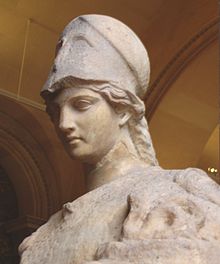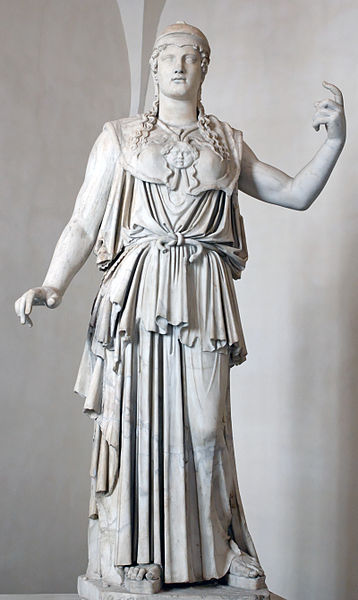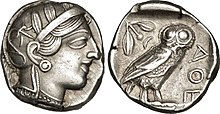|
Greek city of
Larissa
in Thessaly under Thessalian League
Thessalian League Bronze 17mm (4.27 grams) Struck 196-146 B.C.
Reference: Sear 2238; B.M.C. 7.62
Head of Athena right, in crested Corinthian helmet.
ΘΕΣΣΑ / ΛΩΝ above and below horse trotting right, corn ear to right.
Following the great victory of the Roman general Flamininus
over Philip V of Macedon, in 197 B.C., the freedom of the Greeks was proclaimed
at Corinth and a number of new autonomous coinages were initiated. Those in the
name of the Thessali were struck probably at Larissa. The Thessalian League
was a loose confederacy of feudal-like city-states and tribes in the Thessalian
valley in Northern Greece
and was run by a few aristocratic Thessalian families (Aleuadae
and Skopadae). The seat of the Thessalian diet was
Larissa
.
You are bidding on the exact item pictured,
provided with a Certificate of Authenticity and Lifetime Guarantee of
Authenticity.

Helmeted Athena with the cista and Erichthonius in his serpent form.
Roman, first century (Louvre
Museum)
In
Greek religion
and
mythology
, Athena or Athene, also
referred to as Pallas Athena/Athene , is the goddess of wisdom, courage,
inspiration, civilization, law and justice, just warfare, mathematics, strength,
strategy, the arts, crafts, and skill.
Minerva
is the
Roman goddess
identified with
Athena.
Athena is also a shrewd companion of
heroes and is the
goddess
of heroic endeavour. She is the
virgin
patroness of
Athens
. The Athenians founded the
Parthenon
on the Acropolis of her namesake
city, Athens (Athena Parthenos), in her honour.
Athena’s veneration as the patron of Athens seems to have existed from the
earliest times, and was so persistent that archaic myths about her were recast
to adapt to cultural changes. In her role as a protector of the city (polis),
many people throughout the Greek world worshiped Athena as Athena Polias
(Ἀθηνᾶ Πολιάς “Athena of the city”). The city of
Athens
and the goddess Athena essentially bear
the same name, “Athenai” meaning “[many] Athenas”.
Patroness

Athenian
tetradrachm
representing the
goddess Athena
Athena as the goddess of philosophy became an aspect of the cult in Classical
Greece during the late 5th century B.C. She is the patroness of various crafts,
especially of weaving
, as Athena Ergane, and was
honored as such at festivals such as
Chalceia
. The metalwork of weapons also fell
under her patronage. She led battles (Athena
Promachos or the warrior maiden Athena Parthenos) as the
disciplined, strategic side of war, in contrast to her brother
Ares, the patron of violence, bloodlust and slaughter—”the raw force
of war”. Athena’s wisdom includes the cunning intelligence (metis) of
such figures as Odysseus
. Not only was this version of Athena
the opposite of Ares in combat, it was also the polar opposite of the serene
earth goddess version of the deity, Athena Polias.
Athena appears in Greek mythology as the patron and helper of many heroes,
including Odysseus
,
Jason
, and
Heracles
. In
Classical Greek
myths, she never consorts with
a lover, nor does she ever marry,earning the title Athena Parthenos. A
remnant of archaic myth depicts her as the adoptive mother of
Erechtheus
/Erichthonius
through the foiled rape by
Hephaestus
. Other variants relate that
Erichthonius, the serpent that accompanied Athena, was born to
Gaia
: when the rape failed, the semen landed on
Gaia and impregnated her. After Erechthonius was born, Gaia gave him to Athena.
Though Athena is a goddess of war strategy, she disliked fighting without
purpose and preferred to use wisdom to settle predicaments.The goddess only
encouraged fighting for a reasonable cause or to resolve conflict. As patron of
Athens she fought in the Trojan war on the side of the Achaeans.
Lady of Athens
Athena competed with
Poseidon
to be the patron deity of Athens,
which was yet unnamed, in a version of one
founding myth
. They agreed that each would give
the Athenians one gift and that the Athenians would choose the gift they
preferred. Poseidon struck the ground with his
trident
and a salt water spring sprang up; this
gave them a means of trade and water—Athens at its height was a significant sea
power, defeating the
Persian
fleet at the
Battle of Salamis
—but the water was salty and
not very good for drinking.
Athena, however, offered them the first domesticated
olive tree
. The Athenians (or their king,
Cecrops
) accepted the olive tree and with it
the patronage of Athena, for the olive tree brought wood, oil, and food.
Robert Graves
was of the opinion that
“Poseidon’s attempts to take possession of certain cities are political myths”
which reflect the conflict between matriarchal and patriarchal religions.
Judgment of Paris

Aphrodite is being surveyed by Paris, while Athena (the leftmost
figure) and Hera stand nearby.
El Juicio de Paris
by
Enrique Simonet
, ca. 1904
All the gods and goddesses as well as various mortals were invited to the
marriage of Peleus
and
Thetis
(the eventual parents of
Achilles
). Only
Eris
, goddess of discord, was not invited. She
was annoyed at this, so she arrived with a golden apple inscribed with the word
καλλίστῃ (kallistēi, “for the fairest”), which she threw among the goddesses.
Aphrodite, Hera, and Athena all claimed to be the fairest, and thus the rightful
owner of the apple.
The goddesses chose to place the matter before Zeus, who, not wanting to
favor one of the goddesses, put the choice into the hands of Paris, a
Trojan prince. After bathing in the spring of
Mount Ida
(where Troy was situated), the
goddesses appeared before Paris. The goddesses undressed and presented
themselves to Paris naked, either at his request or for the sake of winning.

Paris is awarding the apple to Aphrodite, while Athena makes a face.
Urteil des Paris by
Anton Raphael Mengs
, ca. 1757
Still, Paris could not decide, as all three were ideally beautiful, so they
resorted to bribes. Hera tried to bribe Paris with control over all
Asia and Europe
, while Athena offered wisdom, fame and
glory in battle, but Aphrodite came forth and whispered to Paris that if he were
to choose her as the fairest he would have the most beautiful mortal woman in
the world as a wife, and he accordingly chose her. This woman was
Helen
, who was, unfortunately for Paris,
already married to King
Menelaus
of
Sparta
. The other two goddesses were enraged by
this and through Helen’s abduction by Paris they brought about the
Trojan War
.
Other epithets were
Ageleia
and
Itonia
.

The Parthenon
, Temple of Athena
Parthenos
Masculinity and
feminism
Athena had an “androgynous compromise” that allowed her traits and what she
stood for to be attributed to male and female rulers alike over the course of
history (such as Marie de’ Medici, Anne of Austria, Christina of Sweden, and
Catherine the Great)
J.J. Bachofen advocated that Athena was originally a maternal figure stable
in her security and poise but was caught up and perverted by a patriarchal
society; this was especially the case in Athens. The goddess adapted but could
very easily be seen as a god. He viewed it as “motherless paternity in the place
of fatherless maternity” where once altered, Athena’s character was to be
crystallized as that of a patriarch.
Whereas Bachofen saw the switch to paternity on Athena’s behalf as an
increase of power, Freud on the contrary perceived Athena as an “original mother
goddess divested of her power”. In this interpretation, Athena was demoted to be
only Zeus’s daughter, never allowed the expression of motherhood. Still more
different from Bachofen’s perspective is the lack of role permanency in Freud’s
view: Freud held that time and differing cultures would mold Athena to stand for
what was necessary to them.
Larissa, sometimes written Larisa on
ancient coins and inscriptions, is near the site of the
Homeric Argissa. It appears in early times, when
Thessaly
was mainly governed by a few aristocratic
families, as an important city under the rule of the
Aleuadae
, whose authority extended over the whole
district of
Pelasgiotis
. This powerful family possessed for many
generations before 369 BC the privilege of furnishing
the tagus, the local term for the
strategos
of the combined Thessalian forces. The
principal rivals of the Aleuadae were the
Scopadac
of
Crannon
, the remains of which (called by the Turks
Old Larissa) are about 14 miles south west. The
inhabitants sided with
Athens
during the Peloponnesian War.
As the chief city of ancient
Thessaly, Larissa was directly annexed by Philip II of
Macedon in 344, and from then on Larissa was under
Macedonian control; in 196 B.C. Larissa became an ally
of Rome and was the headquarters of the
Thessalian League
.
Thessaly was home to an extensive
Neolithic
culture around
2500 BC
.
Mycenaean
settlements have also been discovered, for example at the sites of
Iolcos
,
Dimini
and
Sesklo
(near
Volos
). Later, in
ancient Greek
times, the lowlands of Thessaly became the home of baronial
families, such as the
Aleuadae
of
Larissa
or
the Scopads of Crannon. These baronial families organized a federation across
the Thessaly region, later went on to control the
Amphictyonic League
in northern Greece. The
Thessalians
were renowned for their cavalry.
In the summer of
480 BC
, the
Persians invaded Thessaly. The Greek army that guarded the
Vale
of Tempe
, evacuated the road before the enemy arrived. Not much later,
Thessaly surrendered. The Thessalian family of
Aleuadae
joined the Persians. In the
Peloponnesian War
the Thessalians tended to side with Athens and usually
prevented Spartan troops from crossing through their territory with the
exception of the army of Brasidas.
Jason of Pherae
briefly transformed the country into a significant military
power, though he was assassinated before any lasting achievements were made. In
the 4th century BC
Thessaly became dependent on
Macedon
and many served as vassals. In
148 BC
the
Romans formally incorporated Thessaly into the province of
Macedonia
, though in 300 AD Thessaly was made a separate province with its
capital at Larissa
.
It was part of the Byzantine Empire and suffered many
invasions. In 977 it was occupied by the Bulgarians, who remained there until
1014. In 1204 he was assigned to
Boniface of Montferrat
and in 1225 to
Theodore Komnenos Doukas
, despot of
Epirus
. From
1271 to 1318 he was an independent despotate that extended to
Acarnania
and Aetolia
,
run by John III Angelos Komneno. In 1309 settled there the
Almogavars
or
Catalan Company
of the East (Societas Catalanorum Magna), which in 1310,
after lifting the siege of Thessalonica, withdrew as mercenaries in the pay of
the sebastocrátor
John II, and took over the country organized in a democracy.
From there went to the
Duchy of Athens
called by the duke Walter I. In 1318, with the extinction of
the dynasty of Angelos, the Almogavars occupied Siderocastron and southern
Thessaly (1319) and formed the
duchy of Neopatria
.
Later it was occupied by the
Serbs
until 1393,
after being dominated by the
Ottomans
. In 1821 participated in the
Greek War of Independence
, but was not recognized as part of
Greece
until
1881.
|














